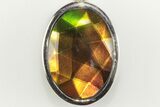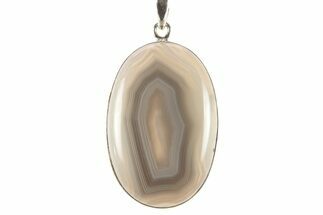This Specimen has been sold.
Colorful Ammolite (Fossil Ammolite Shell) Pendant With BC Jade
This is a gorgeous Alberta ammolite pendant set in sterling silver. The oval-shaped ammolite bears stunning green, red, and orange coloration. The opposite side of this pendant contains a polished piece of nephrite jade that comes out of the BC Jade Mine in Jade City, Canada.
It is accompanied by a 24" long, silver plated snake chain necklace.
It is accompanied by a 24" long, silver plated snake chain necklace.
About Ammolite
Ammolite is an opal-like gemstone found primarily in Alberta, Canada. It is a kind of fossilized shell from ammonites, which in turn are composed primarily of aragonite, the same mineral contained in nacre (mother-of-pearl). The shell's microstructures are often preserved. In 1981, ammolite was given official gemstone status by the World Jewellery Confederation (CIBJO).
An iridescent opal-like play of color is shown in fine specimens, mostly in shades of green and red; howver, all the spectral colors can be seen. This iridescence is due to the aragonite's microstructure: unlike most other gems, whose colors come from light absorption, the iridescence in ammolite comes from interference with the light that rebounds from stacked layers of thin platelets that make up the aragonite. The thicker the layers, the more reds and greens are produced; the thinner the layers, the more blues and violets predominate. Blues and especially purples are the rarest colors, owing to the greater fragility of the finer layers responsible for these colors.
Ammolite is an opal-like gemstone found primarily in Alberta, Canada. It is a kind of fossilized shell from ammonites, which in turn are composed primarily of aragonite, the same mineral contained in nacre (mother-of-pearl). The shell's microstructures are often preserved. In 1981, ammolite was given official gemstone status by the World Jewellery Confederation (CIBJO).
An iridescent opal-like play of color is shown in fine specimens, mostly in shades of green and red; howver, all the spectral colors can be seen. This iridescence is due to the aragonite's microstructure: unlike most other gems, whose colors come from light absorption, the iridescence in ammolite comes from interference with the light that rebounds from stacked layers of thin platelets that make up the aragonite. The thicker the layers, the more reds and greens are produced; the thinner the layers, the more blues and violets predominate. Blues and especially purples are the rarest colors, owing to the greater fragility of the finer layers responsible for these colors.
SPECIES
Placenticeras sp.
LOCATION
Southern Alberta, Canada
FORMATION
Bearpaw Formation
SIZE
.76" tall (entire pendant), .54" tall ammolite stone
CATEGORY
SUB CATEGORY
ITEM
#205942
We guarantee the authenticity of all of our specimens.
 Reviews
Reviews













